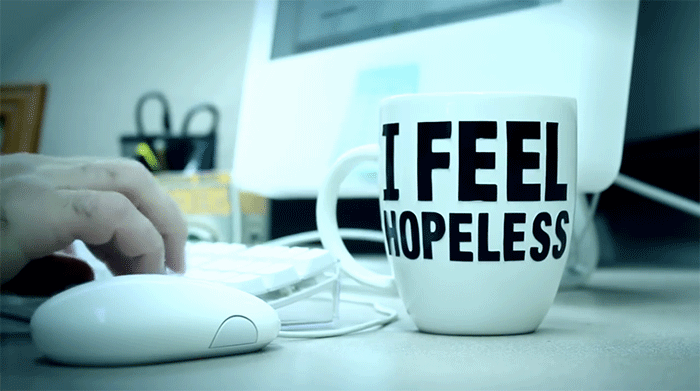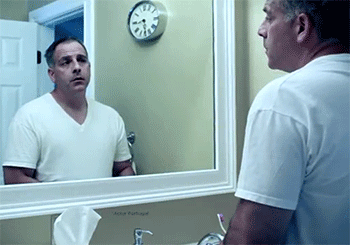
SAVE’s public service announcement “Little Victories” targeting suicidal middle-aged men. Courtesy Blue Sky Riders, SAVE.
By Lee Landor
[Note: This article originally appeared in the May issue of Long Island Pulse Magazine. The stills are taken from SAVE’s PSA, “Little Victories,” by the Blue Sky Riders. This content is the rightful property of Long Island Pulse Magazine, SAVE and the Blue Sky Riders, respectively.]
People always told Claudine Guerra that her husband resembled Robin Williams, so it hit close to home when the actor committed suicide last August. “From the outside looking in, Robin Williams looked like he had everything you could want,” said Guerra, who lives in Sayville with her two young children. “Same thing with my husband.” Robert Guerra, 50, had a great job as the IT director for North Shore-LIJ Health Systems. He was highly regarded in his field, earned a sizeable salary and received job offers regularly. He was well established in the community and had a close group of friends and a loving family.
Like Williams, who was 63 at the time of his death, Robert was enjoying success in the prime of his life. Also like Williams, Robert hanged himself in his own home. In the weeks before their deaths both men suffered from depression, anxiety and paranoia. They weren’t alone.
Throughout the last two years, members of the baby boom generation (those born between 1946 and 1964)—men in particular—have been turning to suicide in greater numbers across the country. In Nantucket, Mass., between October and February 2015 alone, seven middle-aged adults committed suicide. While experts admit they can’t pinpoint a specific reason for the trend, they have an idea of what factors are contributing. “Drugs and alcohol are an issue for this age group,” said Jill Harkavy Friedman, vice president of research for the American Foundation for Suicide Prevention (AFSP). “Unemployment may have contributed by increasing stress on vulnerable people.”
Fran Karliner and Theresa Buhse of the Bellmore-based Long Island Crisis Center (LICC), which operates a suicide hotline, have attributed the rising rates to substance abuse, depression and social and economic pressures. The center, which obtains data from callers, found that over the last four years the number of male baby boomer callers increased 105 percent—60 percent for those specifically with suicide ideation.
Karliner, LICC’s director of development, noted that as a result of the Great Recession that ended in 2009 (from which the world is still recovering), many baby boomers became members of the “sandwich generation”—people who are financially responsible for aging and ailing parents, as well as post-college age children who are returning to live at home. According to the Pew Research Center, 15 percent of middle-aged adults fall into that category.
Buhse, the center’s associate executive director, said the resulting stress and pressures compound depression, anxiety and other mental illnesses that lead to isolation and loneliness. For a generation of people who were taught that you don’t air dirty laundry, it’s a recipe for disaster.
In 2013, the highest suicide rate—19.1 deaths per 100,000—was among people 45 to 64 years old, and nearly 78 percent of all suicide deaths in the country were those of men, according to the AFSP and the Centers for Disease Control. And though women are five times more likely to attempt suicide, men are seven times more likely to complete it, according to Buhse. Middle-aged men are now considered the highest risk for death by suicide, overtaking even the elderly, who have historically held the title.
Men are much less likely to reach out for help,” Karliner said. “A woman will talk to other people, will reach out for help, but men have been taught that you keep your feelings inside, that it’s a sign of weakness to ask for help.”

SAVE’s public service announcement “Little Victories” targeting suicidal middle-aged men. Courtesy Blue Sky Riders, SAVE.
That’s certainly what Robert Guerra learned growing up in Wantagh with a hard-nosed military father who believed men had to be tough and that it was unacceptable to talk about emotions, worries and woes. “I always tried to encourage my husband to go [to therapy], but he didn’t believe in any of that kind of thing,” his widow said. Thinking her husband was experiencing a mental breakdown, Guerra had, in fact, made an appointment for him to see a therapist. It was scheduled for two days after his death on April 15, 2013.
“People are going to tell you a million times that it’s not your fault,” she said, “but you’re always going to feel that it partly is.” Guerra still struggles with guilt and acceptance, but her grief is slowly healing with the help of a counselor from Joe’s Project, an organization that provides mental health and support services, as well as a 24/7 hotline, to Suffolk County residents directly impacted by suicide. Acceptance is the ultimate goal for Guerra. “My best advice to somebody who’s gone through this is just accept that you’re never going to have an answer, because I’ve gone over it a million times since it’s happened and I don’t understand it any more today.”
It’s taken Janice Alfieri about five years to find acceptance and closure, and not only from guilt, but also from shame. Alfieri’s 63-year-old husband, Larry Fulgieri, slit his wrists in the kitchen of their Bayside home in 2009. “I find as a widow that people shy away from me,” she said, noting that the stigma surrounding suicide characterizes it as selfish and cowardly. “There wasn’t a selfish bone in his body,” Alfieri said of her husband of 29 years. “He just needed the pain to go away—not only physical, but mental.” Fugieri had become dependent on painkillers following an injury sustained in a car accident three years prior. The torment of chronic pain coupled with the struggle of addiction left the retired sheet metal worker unable to do the things he loved most: boating, fishing and cooking meals for his traditional Italian family. “Everything became a chore for him and he felt he was holding me back.”
Feeling like a burden or a failure is common among suicidal baby boomer men, according to Suicide Awareness Voices of Education (SAVE) Executive Director Dan Reidenberg, who’s been focusing efforts on prevention for the cohort. “The baby boom generation is a very motivated, highly energized population. They were very successful,” Reidenberg said. “As they move into older age, there are fewer opportunities for them to carry on that ability to contribute as much to society…to keep that identity that helped them be so successful. Their income drops, their earning potential diminishes, they lose people more. The older they get, the more physical ailments they have. All of these things begin to really weigh on people.”
SAVE’s most recent campaign targets adult men, ages 25 to 54, and aims to increase help-seeking behaviors. It includes public service announcements and television, radio and print advertisements featuring middle-aged men who appeal directly to the feelings of ineptness and hopelessness. Last fall, SAVE ran the ads and PSAs on the jumbotron at Lambeau Field during Green Bay Packers games. It also plans to run them this year at the Indianapolis 500, Daytona 500 and Brickyard 400. “The idea is to reach into those audiences…so that they can see that it is ok to ask for help,” said Reidenberg, who also serves as managing director of the National Council for Suicide Prevention and as US representative to the International Association of Suicide Prevention.
But in order to really bolster the conversation about suicide, people need to start talking about mental illness, according to Jessica Hutchison, a Chicago-based licensed clinical counselor and a suicide loss survivor. Hutchison lost her 63-year-old father, Robert Levstik, to a self-inflicted gunshot wound two days after Christmas in 2011. According to his daughter, the retired civil engineer had always been a gentle soul—a bellbottom-wearing, gun-hating, peace-loving hippie—until mental illness obliterated his health, happiness and hope. “Yes, my dad died by suicide,” Hutchison said, “but the depression and anxiety are what took his life.”
Along with two other Chicago-based women who lost their fathers to suicide, Hutchison co-founded the blog Our Side of Suicide to provide support to other survivors and to bring the subject of mental illness to the forefront. The AFSP has been working toward the same goal, making outreach and awareness priorities. “Knowledge is power,” said Dale Camhi, the AFSP’s Metro-New York regional director. “If we know what to look for and what to do, maybe we stand a chance of bringing the rate of suicide down.”
And more and more Long Islanders are joining the cause. Last fall, more than 4,000 people attended the AFSP’s annual “Out of the Darkness” suicide prevention and awareness walk at Old Westbury Gardens. Among them was Sharon Uss, whose father, Robert Nielsen—a 52-year-old sergeant with the Long Beach Police Department—took his service weapon to his head on Easter Sunday in 2002. “It’s not a somber, sad event,” said Uss, who’s walked for the last three years. “It’s just amazing to see all the people who are there. You don’t feel alone.”
Connecting with others who understand the impact of suicide is one of the reasons Alfieri has decided to participate in this year’s 12th annual walk. “I’ve come out of the closet,” she said. “People need to know that normal people from good homes—from every walk of life—face this and there’s nothing for us to be ashamed of.”
Robin Williams’ death was a testament to that, according to Guerra. “I think people were just genuinely sad that we lost such a great entertainer and someone who seemed like such a good, caring person,” she said, noting yet another similarity between the actor and her husband. “I think people generally felt sad for [Robert]. I don’t think they thought he was crazy.”
Reflecting on the tragedy that struck her life, Guerra’s advice is to just keep communicating. “Not talking about it doesn’t change anything. People have to be aware that [depression is] an awful illness. Don’t be afraid to say that you’re struggling.”
Resources for those Contemplating Suicide
Long Island Crisis Center
Hotline: (516) 679-1111
Online chatting: licconline.org
Live texting: Text “LICC” to 839863
National Suicide Prevention Lifeline
Hotline: (800) 273-8255
Resources for Survivors:
American Foundation for Suicide Prevention,
Metro-New York Chapter Survivor Outreach hotline: (516) 869-4215
Joe’s Project
Hotline: (888) 375-2228